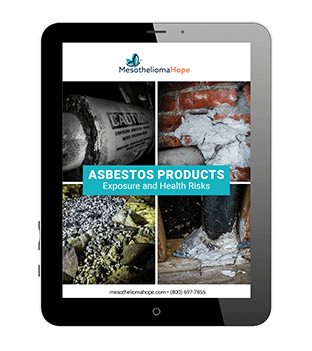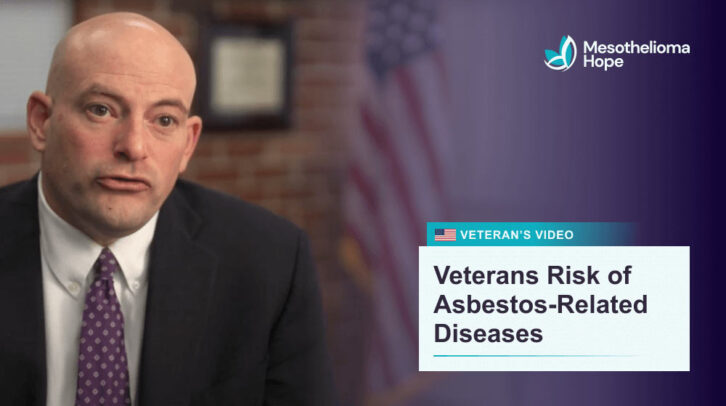List of Asbestos Related Diseases
Breathing in or swallowing asbestos fibers can lead to a variety of illnesses that may not present symptoms until many years after exposure.
These asbestos-related diseases include:
- Asbestosis
- Atelectasis (lung collapse)
- Chronic obstructive pulmonary disease (COPD)
- Laryngeal cancer
- Malignant mesothelioma
- Ovarian cancer
- Peritoneal ascites
- Pleural effusion
- Pleural plaques
- Lung cancer
- Pleural thickening

For much of the 20th century, asbestos was one of the most commonly used materials in U.S. manufacturing, shipbuilding, construction, and a wide range of other industries due to its low cost and natural fireproofing properties.
Millions of Americans were exposed to asbestos for decades with no idea of how dangerous it was. This is because the manufacturers of asbestos-containing products hid the health risks to keep making money.
However, we now know that all forms of asbestos are carcinogenic (capable of causing cancer). Asbestos exposure can also cause serious non-cancerous diseases.
Learn more about the connection between asbestos exposure and illnesses like mesothelioma and lung cancer in our Free Asbestos Guide.
The Health Hazards of Asbestos Exposure
When asbestos-containing materials are moved or damaged, they can release microscopic fibers into the air. These asbestos fibers can linger for hours and be breathed in or swallowed by anyone nearby.
Once asbestos is inside the body, it can trigger inflammation, scarring, and damage to tissues and organs. This continued inflammation can cause mesothelioma and other asbestos diseases to develop later in life.
“When released into the air, inhaled asbestos fibers enter the upper and then lower respiratory tracts.
Asbestos fibers are recognized by the lungs as foreign bodies and cause the activation of the lungs’ local immune system, leading to Inflammation and cell and tissue damage.”
– Center for Asbestos Related Disease
Key Facts About Diseases Related to Asbestos
- Patients affected: Most asbestos related diseases affect workers; about 125 million people worldwide are exposed to asbestos in the workplace
- Types of asbestos diseases: Benign (non-cancerous), such as asbestosis and pleural plaques, and malignant (cancerous) diseases, such as mesothelioma and lung cancer
- Symptoms (if present): Fluid buildup, cough, chest or stomach pain
- High-risk groups: Former blue-collar workers, veterans, and smokers
- Financial assistance options: Asbestos trust fund claims, lawsuits, and VA disability benefits
Who Develops Asbestos Related Diseases?
Veterans have a higher risk of asbestos diseases due to the U.S. military’s widespread use of asbestos-containing products to build ships, barracks, vehicles, and other assets from the 1930s to the early 1980s.
Blue-collar workers who spent time in industries like construction, plumbing, and automotive repair are another high-risk group. Their families could also be at risk if they breathed in asbestos fibers left on their loved one’s clothes or hair.
Further, some people are more genetically predisposed to developing an asbestos disease. Certain lifestyle factors are also linked to asbestos diseases. For example, smokers have a greater chance of developing an asbestos-related lung disease after exposure than non-smokers.
U.S. veterans who were exposed to asbestos could develop diseases like mesothelioma, asbestosis, and lung cancer decades later. Call (866) 608-8933 to get help after a diagnosis. View Transcript.
Duration: 1 min 01 sec
Veterans who served in the military between the 1930s and the 1980s were likely exposed to asbestos while they were on active duty.
Usually, if you’ve developed an asbestos-related disease, you developed that disease because you had an excessive amount of exposure to asbestos.
If a veteran believes they were exposed to asbestos while serving in the military, we encourage them to call MesotheliomaHope.com so that we can work together to help them file for VA benefits.
The VA will recognize any asbestos-related disease as long as your asbestos exposure happened while you were on active duty in the military.
In addition to VA benefits, MesotheliomaHope.com can connect veterans with world-renowned physicians and nurses on staff that can answer any of your treatment questions. We encourage veterans to call and find out how we can help them.
Asbestos Related Cancers
Asbestos exposure can lead to several types of cancers, most notably mesothelioma.
If you’ve been diagnosed with asbestos related cancer, early intervention can significantly impact your treatment outcomes and improve your life expectancy.
Keep reading to learn more about mesothelioma, lung cancer, and other types of cancers from asbestos.
Mesothelioma
Mesothelioma is a rare cancer that affects the thin lining of certain organs, most commonly the lungs (pleura). It can also occur in the abdominal lining (peritoneum) or heart lining (pericardium).
About 3,000 cases of mesothelioma are diagnosed in the U.S. each year — and asbestos exposure is the only known cause of the disease.
Because the symptoms of mesothelioma can mimic less severe illnesses, it’s important to tell your doctor about any previous exposure to asbestos. They can order imaging scans like chest X-rays and have a fluid or tissue biopsy done to see if you have mesothelioma.
Get our Free Mesothelioma Guide shipped overnight to learn more about this cancer and your treatment options after a diagnosis.
Lung Cancer


Lung cancer is a significant concern for anyone who has a history of asbestos exposure.
Between 10% and 15% of lung cancer cases are linked to asbestos, according to a 2022 report in the International Journal of Environmental Research and Public Health.
When you breathe in asbestos fibers, they can become lodged in your lungs, causing irritation and inflammation over several decades. The fibers can interfere with normal lung function and may lead to the growth of cancer cells.
There are two types of asbestos related lung cancer:
- Non-small cell lung cancer (NSCLC): This is the most common type of lung cancer associated with asbestos exposure. NSCLC includes subtypes such as adenocarcinoma, squamous cell carcinoma, and large cell carcinoma.
- Small cell lung cancer (SCLC): Asbestos exposure has also been linked to SCLC, a less common but more aggressive form of the disease.
Ovarian Cancer
Ovarian cancer develops on the outer surface of the ovaries, which are the small, oval-shaped glands located on both sides of the uterus.
A case study published in the Annals of Occupational and Environmental Medicine highlighted a 57-year-old woman who visited the hospital because of difficulty urinating and was then diagnosed with ovarian cancer. The woman worked in an asbestos textile factory during the 1970s.
Peritoneal mesothelioma is often mistaken for ovarian cancer because of how close the abdominal lining is located to the ovaries. Therefore, it’s important to see your doctor if you think you’ve been misdiagnosed.
Laryngeal Cancer
Like the lungs, the larynx (voice box) is located in the direct path of inhaled asbestos fibers. These fibers can become trapped in the larynx once breathed in.
The larynx can suffer long-term damage and inflammation from the asbestos fibers, which can cause cellular changes that increase the risk of cancer.
The standard treatments for laryngeal cancer are surgery and radiation therapy, according to the National Cancer Institute (NCI).
Other Cancers
The Centers for Disease Control and Prevention (CDC) notes that asbestos exposure can increase the risk of other types of cancers.
These related cancers include:
- Colorectal cancer
- Pharyngeal (throat) cancer
- Stomach cancer
Download our Free Asbestos Guide to learn more about asbestos related diseases and the products that cause them.
Benign (Non-Cancerous) Asbestos Related Diseases
Besides cancer, asbestos can cause illnesses like asbestosis and pleural plaques. Many of these illnesses can be managed with treatment.
Learn more about the most common types of benign asbestos related diseases below.
Asbestosis
Asbestosis is an asbestos related pleural disease that develops when inhaled asbestos fibers cause scar tissue (fibrosis) to form inside the lung and pleura. It’s also referred to as pulmonary fibrosis or interstitial pneumonitis.
Around 50% of adults with occupational asbestos exposure develop asbestosis. Patients with asbestosis commonly have shortness of breath and chest pain, especially during physical activity.
Asbestosis is also a significant risk factor for pleural mesothelioma, which affects the lining of the lungs (pleura).
Pleural Plaques
Pleural plaques occur when the membranes of the lungs and the inside of the ribcage thicken, causing a buildup of calcified collagen (plaque).
They are the most common asbestos related disease, according to the Agency for Toxic Substances and Disease Registry (ATSDR). Thankfully, pleural plaques are usually not dangerous and rarely cause symptoms.
In rare cases, pleural plaques become widespread and thick, which usually indicates a more serious asbestos-related disease.
Pleural Effusion
Pleural effusion is the buildup of excess fluid that pushes on the lungs. Pleural effusions occur between the two layers of the pleura.
According to Cleveland Clinic, pleural effusions can cause symptoms such as a dry cough, difficulty breathing, and chest pain. Doctors can surgically drain the excess fluid to ease these symptoms.
Pleural effusions are often a symptom of pleural mesothelioma, which is a serious disease but may be better managed when caught early. If you’re experiencing signs of fluid buildup, it’s a good idea to see a specialist for a physical examination.
Other Benign Asbestos Diseases
Although uncommon, asbestos exposure can sometimes cause other benign diseases and conditions:
- Chronic obstructive pulmonary disease (COPD) is a progressive disease that causes severe shortness of breath. It’s often caused by smoking, but inhaling asbestos fibers can also trigger COPD.
- Diffuse pleural thickening develops when scarring from asbestos fibers thickens the lungs and lining of the chest wall.
- Peritoneal ascites occurs when fluid builds up in the lining of the abdomen. Ascites is also a common symptom of peritoneal mesothelioma cancer.
- Rounded atelectasis, also known as folded lung or Blesovsky syndrome, occurs when a small, rounded portion of the lung collapses. Asbestos exposure has been linked to certain cases of rounded atelectasis.
You may be eligible for financial assistance for treatment and living expenses. Call our team of Patient Advocates now at (866) 608-8933 to learn more.
Financial Help Available for Asbestos Related Diseases
The makers of asbestos-containing products were aware that exposure could make people sick, but they chose not to inform the public or the U.S. military about the risks — all so they could continue making profits.
Today, asbestos related disease victims may be able to seek financial compensation from these companies through a few different avenues.
These options include:
- Asbestos lawsuits: Victims can pursue compensation by filing a lawsuit against the manufacturers responsible for their illness. On average, these lawsuits result in settlement awards of more than $1 million.
- Asbestos trust funds: Some manufacturers declared bankruptcy to avoid lawsuits but were required to establish trust funds to compensate victims. Currently, over $30 billion is available in asbestos trust funds, and many victims start receiving their first payouts within 90 days.
- Veterans benefits: Veterans with asbestos related diseases may also be able to receive monthly disability benefits from the U.S. Department of Veterans Affairs (VA) up to nearly $4,000 each month if they have a dependent spouse.
Mesothelioma Hope’s team of legal advocates can help you file claims to get compensation for your asbestos related illness. Get a free consultation to see if you qualify.
See If You’re Eligible for Asbestos Compensation
Mesothelioma Hope is here to offer medical support and legal guidance to families impacted by asbestos related diseases.
Whether you or a loved one has been diagnosed with mesothelioma, lung cancer, or another asbestos-related condition, we can help determine if you can take action and secure financial payouts from the asbestos companies responsible.
Contact us today at (866) 608-8933 to explore your options and take the first step toward securing the compensation you deserve.
Asbestos Related Diseases FAQs
How much asbestos exposure is harmful?
There is no known safe level of asbestos exposure. Even low levels of exposure to asbestos fibers can lead to asbestos related diseases.
Those at the highest risk of exposure worked with or around asbestos-based products on a daily basis. The use of asbestos in industries like construction, shipbuilding, and mining posed significant health risks to the public for much of the 20th century.
What are the 4 major asbestos-related diseases?
The four major asbestos-related diseases are:
- Mesothelioma: This is a rare and aggressive cancer that primarily affects the thin lining of the lungs (pleura) but can also occur in the abdomen (peritoneum) or around the heart (pericardium). The only known cause is asbestos exposure.
- Lung cancer: Asbestos exposure increases the risk of lung cancer. It often occurs in individuals who have a history of both asbestos exposure and smoking.
- Asbestosis: Asbestosis is a chronic lung disease caused by breathing in asbestos fibers. Over time, these fibers can cause scarring of the lung tissue, which prevents the lungs from working.
- Pleural plaques: Pleural plaques are areas of thickened and calcified tissue that develop on the pleura (the lining of the lungs and chest cavity). While they are benign (non-cancerous), they are considered a marker of asbestos exposure and are often diagnosed in patients with mesothelioma.
How do I know if I have been exposed to asbestos?
Asbestos was widely used in building materials and other products until the 1980s.
If you worked in any of the following industries, you may have been exposed to asbestos:
- Automotive repair
- Construction
- Insulation
- Manufacturing
- Mining
- Shipbuilding
Veterans who served in the armed forces at any point between the 1930s and the early 1980s may also have been exposed to asbestos since it was used extensively throughout Navy ships, aircraft, and military buildings.
If a family member worked in high-risk occupations and brought asbestos fibers home on their clothing, you could have been exposed to asbestos secondhand.
If you think you may have been exposed to asbestos, make sure to consult your health care provider. They can evaluate your risk based on your work/military history and may recommend imaging scans and other testing.
How soon after asbestos exposure do you get sick?
It can take 10 to 50 years to become sick with an asbestos related disease. The delayed development of asbestos diseases is known as the latency period.
The latency period can vary based on the length of asbestos exposure, the concentration of asbestos fibers, and environmental and lifestyle factors.
What illnesses are related to asbestos exposure?
There are a variety of illnesses that can be traced to asbestos exposure, including:
- Mesothelioma: A rare and aggressive cancer that affects the thin lining of the lungs, abdomen, or heart. It’s directly associated with asbestos exposure.
- Lung cancer: Asbestos exposure increases the risk of developing lung cancer, particularly among those who smoked.
- Asbestosis: A chronic lung condition caused by inhaling asbestos fibers that leads to lung scarring and breathing difficulties.
- Pleural effusion: Fluid buildup between the layers of the pleura.
- Pleural plaques: Non-cancerous thickened areas on the pleura (lung lining) that are considered a sign of asbestos exposure.
- Pleural thickening: Scarring and thickening of the pleura, which can cause breathing problems.
- Peritoneal ascites: The abnormal accumulation of fluid in the abdominal cavity.
- Laryngeal cancer: Cancer affecting the voice box that can be linked to asbestos exposure.
Can you recover from asbestos exposure?
Possibly, yes. First, it’s important to note that not everyone who is exposed to asbestos develops a related illness. There isn’t a way to lower your risk of getting sick if you were already exposed.
If you do have an asbestos-related illness, recovery depends on the disease you have, when you’re diagnosed, and other factors.
Asbestosis, a chronic asbestos related lung disease, can be managed with oxygen therapy and breathing treatments, especially if diagnosed early.
Asbestos lung cancer and mesothelioma have better outcomes with early diagnosis and treatments like surgery, chemotherapy, and immunotherapy.






